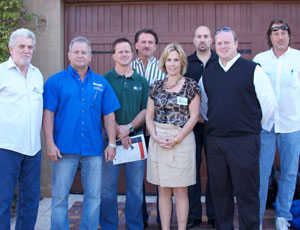Real-World Remediation For instance, one luxury homebuilder in Palm Beach County, Fla., has turned into an expert on Chinese drywall remediation as a multiyear backlog of work ramps up and South Florida’s homebuilding industry attempts to address the issue.

Julie Miller, president of Kogen Construction Co. in Boca Raton, Fla., estimates that about one third of her business—and most of her time—is now dedicated to bidding and remediating homes afflicted with the “reactive” drywall syndrome.
The guidelines recently issued by the Consumer Product Safety Commission are a welcome starting point for contractors attempting to get this repair work right, Miller says. “The guidelines fortify the builders that want to take everything out.”
The guidelines may boost remediation efforts in general, Miller says, but not much. “The real issue is money,” she says
The guidelines’ biggest impact may be to level the field for contractors by creating a baseline for remediation. Not all contractors have been performing to the same standards to date.
For instance, Miller says her firm lost out on its first five bids to a contractor that was only snipping the ends of the electrical wiring, for instance, instead of replacing all of it. Another contractor has been only cutting out and replacing the affected drywall.
But those may be the exceptions. The work of at least some firms busy in the emerging remediation industry may already surpass the federal instructions. In addition to removing all of the affected drywall and certain electrical and life-safety systems, such as fire detectors, as the guidelines indicate, firms like Kogen—and there are a growing number—are doing much more.
Miller’s company completely rewires the houses, which she says requires removal and replacement of the ceiling, for instance, and replaces the insulation, carpeting, appliances and, sometimes, cabinetry.
“The guidelines say you just have to remove affected drywall,” Miller says. “But if you don’t remove the ceiling, you’re keeping the smell. And it’s nearly impossible to rewire the whole house with the ceiling in.” Removing insulation is also mandatory to get rid of the odor. And replacement of copper wiring is already considered standard by some firms as well.
“The people I’m peer-reviewing with are all in agreement – everything goes,” she says. Miller—who has never had a client impacted by Chinese drywall because she says she never installed any—says she works closely with other firms delving into the remediation market to share best practices and generally educate each other about the evolving science and technology.
To date, much of the remediation work that Kogen has completed has been for high-end customers that can afford to fund the fixes. Kogen’s most expensive remediation job to date is a 5,000-sq-ft project priced at $220,000. A recent 3,200-sq-ft home cost just $87,000 to remediate, however.
“You can’t just throw out a square-foot number,” Miller says.
The national homebuilders are starting to move forward on it, and foreclosures and short-sales are generating remediation work, too.
“The only homes that are really going (forward currently) are people who bought the homes either in foreclosure or short sales and they got them for such a ridiculously low level” that they can afford to remediate.
At the same time, condominium units are starting to show signs of the problem. A 54-unit condo that needs Chinese drywall remediation throughout recently went out for bids, Miller says. Two other condo buildings are being priced for remediation, Miller says, though she says those owners currently have no funding for the work.
And the size of the market hasn’t been fully defined yet, either, as symptoms of Chinese drywall are still emerging.
“The projects I’m seeing now are the homes and condominiums that were built in 2005,” she says. “There’s going to be that lag time.” If she’s right, that means that projects—including condos—built in 2006 or even later will eventually need remediation.
“There are people who are just discovering now that they have it,” Miller says. She cites a 10,000-sq-ft home that a year ago showed no signs of the problem but is now in need of remediation.
“As these months start heating up, people are going to start realizing there’s a problem when their house starts stinking,” Miller says.
In all, Miller expects there to be at least three years of remediation work ahead. For now, she says, she’s working with other firms to give homeowners and major developers a good price, sometimes cutting her fee in half.
Even though none of her remediation customers are the victims of her own company’s previous efforts, Miller still thinks it’s wrong to profit extensively from this situation. “I don’t want to walk away with a huge profit on this; it’s just not right,” she says. “I feel like we have to give back a little bit to this problem.”
However, she quickly adds: “It hopefully gets me the jobs, too!”



Post a comment to this article
Report Abusive Comment